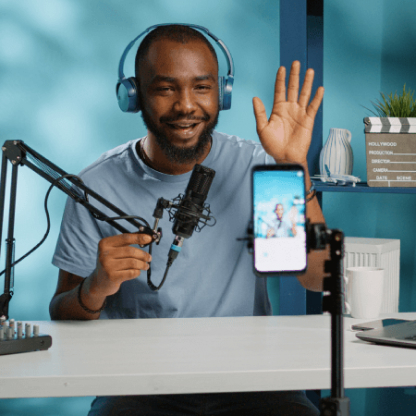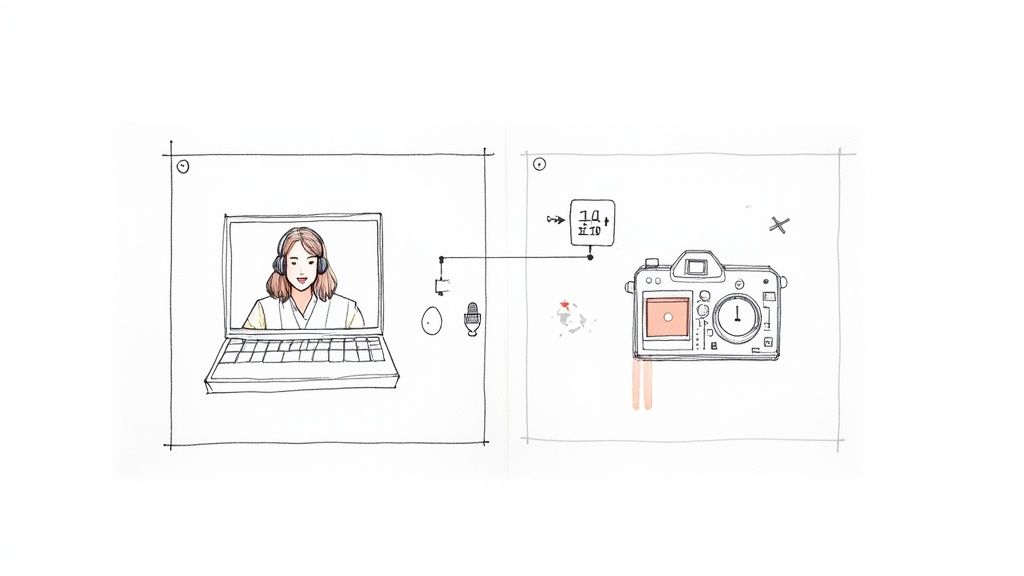Let’s be honest, hiring feels like a second full-time job you never asked for. One minute you’re building something incredible, the next you’re drowning in a sea of suspiciously perfect resumes, jargon-filled cover letters, and scheduling nightmares. It’s a painful, time-consuming process that often feels more like gambling than a strategic business function. The good news? It doesn't have to be this way. Turns out there’s more than one way to find elite talent without mortgaging your office ping-pong table.
I've made the mistakes so you don't have to. We've gone from chaotic, gut-feel hires to a repeatable, data-backed system. This article isn't a collection of generic tips from a textbook; these are the hard-won lessons from the trenches. These are the 10 best practices for recruitment that will actually save you time, money, and your sanity. To navigate the complexities of hiring successfully, understanding and applying the Top Talent Acquisition Best Practices for 2025 is essential for building a predictable pipeline.
What follows is a no-fluff guide to building a hiring engine that works. We will cover everything from defining what you actually need and sourcing talent beyond LinkedIn to running interviews that predict performance and creating a candidate experience that wins you top contenders. Let’s get into it.
1. Get Painfully Specific About Who You Need
Ever posted a job and gotten a flood of applicants who were… let's just say, creatively qualified? The root of this problem isn't a lack of talent; it's a blurry target. Defining clear job requirements is the single most critical, non-negotiable step. Skipping this is like building a house without a blueprint. You'll get something, but probably not what you wanted, and fixing it will be expensive.
This isn't just about listing software skills. It’s about sitting down with your hiring manager and hammering out what success actually looks like in this role. What are the essential qualifications, the non-negotiable experiences, and, crucially, the behavioral traits that separate the good from the great? You’re crafting a detailed profile of your ideal hire before you even think about writing the ad.

Why It Works & How to Do It
Companies like Netflix don’t just stumble upon top talent. They famously integrate their culture deck principles directly into job descriptions, attracting candidates who are already aligned with their high-performance mindset. They screen for fit from the very first sentence.
Here’s how you can make this one of the best practices for recruitment in your own workflow:
- Interview Your Top Performers: Sit down with someone who is crushing it in a similar role. Ask them what makes them successful, what challenges they face, and what a typical day actually looks like. Steal their insights.
- Use SMART Criteria: Make your requirements Specific, Measurable, Achievable, Relevant, and Time-bound. Instead of "strong communication skills," try "must be able to present quarterly performance data to senior leadership without putting them to sleep."
- Write a ‘Day in the Life’: Add a short scenario-based section. This gives candidates a real taste of the job and helps them self-select out if it’s not for them.
- Review and Refresh Quarterly: Roles evolve. Don’t let your job descriptions get stale. A quarterly check-in ensures they always reflect the current needs of the business, not the needs of last year.
2. Stop Fishing in a Bathtub
Relying on a single job board is like fishing in a bathtub and expecting to catch a marlin. You might get a bite, but you’re missing an entire ocean of talent. To find the best people, you need to cast a wide, intelligent net. Leveraging multiple sourcing channels means actively seeking candidates where they live, work, and network online, not just waiting for them to find your "Careers" page.
This strategy involves diversifying your outreach across a mix of platforms like professional networks, social media, employee referrals, and niche communities. It’s about being proactive, not passive. You’re moving from being a job poster to a talent hunter, building a pipeline of candidates from various backgrounds and skill sets.
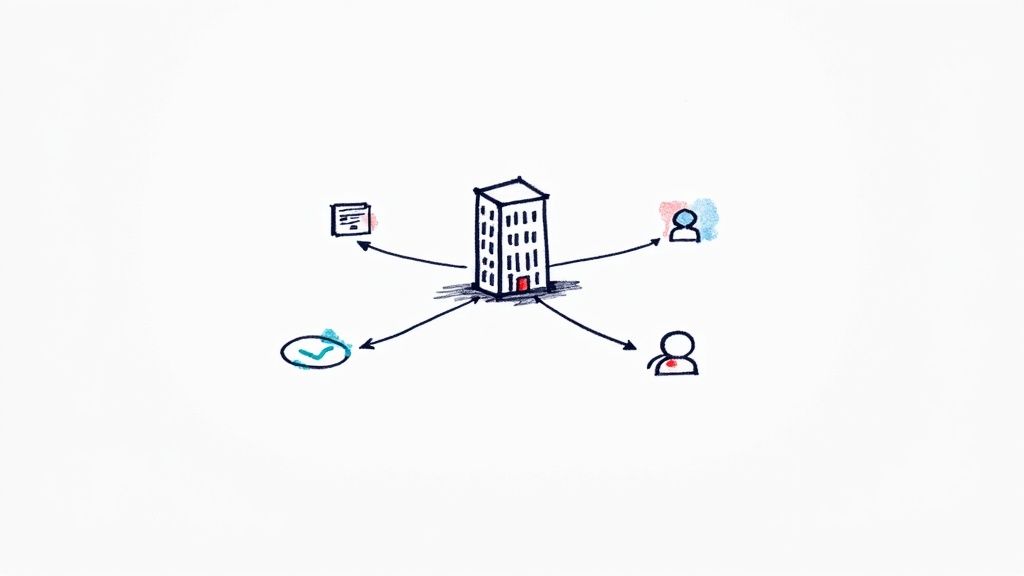
Why It Works & How to Do It
Companies that excel at this don't just post and pray. Zappos became legendary for its innovative social media campaigns that attracted people who were a natural fit for their quirky, customer-obsessed culture. This isn’t just about volume; it’s about strategic reach.
Here’s how to stop fishing in the bathtub and start exploring the open seas:
- Actually Track Your Sources: Use your Applicant Tracking System (ATS) or even a simple spreadsheet to monitor which channels deliver the best candidates. Double down on what works, and ruthlessly cut what doesn't.
- Tailor Your Message: A LinkedIn InMail message should not read like a formal job post. Adapt your tone, content, and call to action for each platform. Speak their language.
- Activate Employee Referrals: Your current team is your best sourcing channel. Period. Create a simple, rewarding referral program that encourages them to tap into their networks. A cash bonus never hurts.
- Go Where the Experts Are: Looking for a specific developer? Check GitHub or Stack Overflow. Hiring a designer? Behance or Dribbble are your spots. Stop expecting them to come to you.
3. Ban the "Nice Chat" Interview
Ever leave an interview panel feeling like everyone just had a nice chat, but nobody knows if the candidate can actually do the job? That’s unstructured interviewing, and it’s basically recruiting malpractice. It’s where gut feelings and unconscious bias thrive, leading to inconsistent, unreliable, and often legally questionable hiring decisions. The antidote is a structured interview process.
This method isn't about being robotic; it's about being fair and effective. It involves asking all candidates for a specific role the same set of pre-determined, competency-based questions. Each answer is then evaluated against a standardized scoring rubric. You’re not just winging it; you’re running a consistent, data-driven process designed to predict on-the-job performance, not just likability.
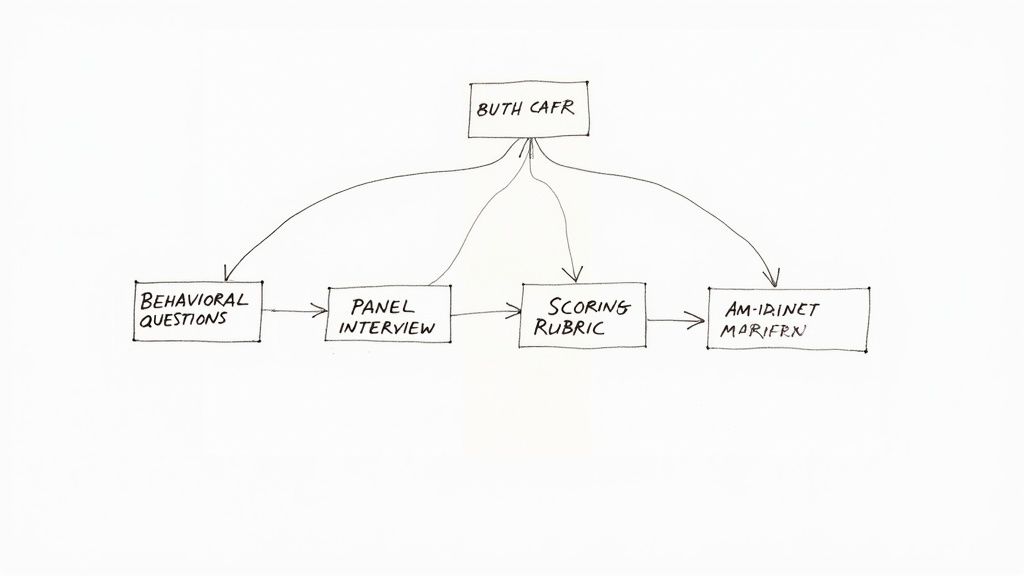
Why It Works & How to Do It
The proof is in the data. Research popularized by Google has shown that structured interviews are significantly better predictors of future job success. Companies like Amazon build their entire loop around Leadership Principles, ensuring every hire is measured against the same high bar.
Here's how you can stop the "nice chat" interviews and start making defensible hires:
- Standardize Your Questions: Develop a bank of behavioral questions linked directly to the core competencies you defined for the role. Ask every single candidate the same core questions. No exceptions.
- Use the STAR Method: Train interviewers to probe for answers using the Situation, Task, Action, and Result (STAR) framework. This forces candidates to provide concrete evidence of their skills, not just vague claims.
- Create a Scoring Rubric: Build a simple 1-5 scale for each question based on pre-defined criteria for what a poor, average, and great answer looks like. This helps calibrate your interview panel and removes subjectivity.
- Train Your Interviewers: Don't just hand someone a list of questions and hope for the best. Train them on structured techniques, how to avoid bias, and how to actually use the rubric. Your gut feeling is not a KPI.
4. Build Your Bench Before the Game Starts
Waiting for the perfect candidate to apply is like waiting for lightning to strike. It happens, but you can’t run a business on it. The best recruiters don’t just find talent; they cultivate it. Building a talent pipeline means you stop reacting to hiring needs and start proactively managing your future workforce. It’s the difference between frantically searching when a key role opens up and simply picking the best person from your pre-vetted, engaged community.
This is about playing the long game. It involves identifying high-potential individuals, engaging with them consistently, and nurturing relationships before you have a job opening. You’re essentially creating a bench of all-stars who are already familiar with your brand and excited about the possibility of joining your team when the time is right.
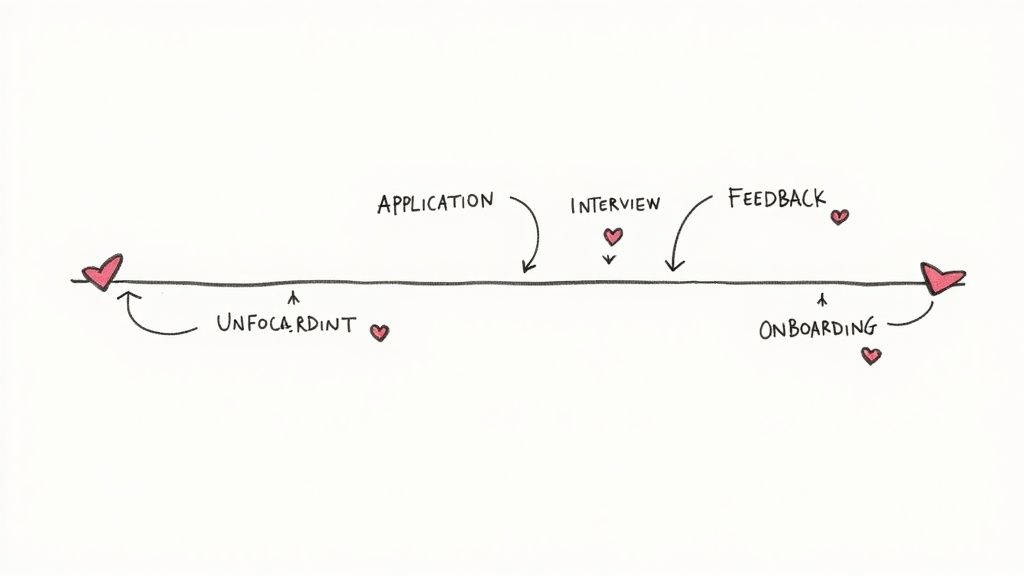
Why It Works & How to Do It
Companies famous for innovation, like Apple and Tesla, are masters of this. They don't just post jobs for engineers; they build entire communities and maintain long-term relationships, ensuring they have a constant flow of qualified individuals ready to be activated. This dramatically reduces time-to-hire and improves candidate quality.
Here’s how to stop scrambling and start pipelining:
- Use a Talent CRM: A spreadsheet won't cut it. Use a CRM to track interactions, segment candidates by skill set (e.g., "Future Marketing Leads," "Senior Backend Devs"), and schedule follow-ups.
- Provide Value, Don't Just Ask: Share relevant industry news, invite them to a company webinar, or send a congratulatory note on a work anniversary. Build rapport, not just a database.
- Engage "Silver Medalists": Keep in touch with excellent candidates who weren't hired for a previous role. They are already vetted and familiar with your company. Reaching out to them is the lowest-hanging fruit there is.
- Host Niche Events: A virtual coffee chat for data scientists or a small online workshop can attract passive candidates and give you a chance to build genuine connections.
5. Stop Ghosting Your Candidates
Ever wonder why top candidates ghost you after a seemingly great interview? Here’s a hint: it probably wasn’t something you said, but rather how the entire process made them feel. Candidate experience isn't a fluffy HR nice-to-have; it's a strategic weapon. Neglecting it is like running a restaurant with a fantastic menu but sticky tables and a rude host. People will leave, and they’ll tell their friends.
This practice is about treating every applicant like a valued customer, regardless of whether they get the job. It involves creating a transparent, respectful, and efficient journey from the first click on your job ad to the final decision. You're not just filling a role; you're building a brand reputation with every single interaction. Get it wrong, and you'll be reading about it on Glassdoor.
Why It Works & How to Do It
Virgin Group's Richard Branson famously calculated that a poor candidate experience was costing Virgin Media millions in lost revenue. They transformed their process, ensuring even rejected candidates felt respected, which directly protected their consumer brand.
Here’s how you can make this one of the best practices for recruitment in your own company:
- Set Clear Timeline Expectations: From the very first email, tell candidates what to expect and when. "We'll be in touch within 5 business days" is a simple promise that builds immediate trust.
- Provide Proactive Updates: Don't leave people in a black hole. A quick, automated email saying "We're still reviewing applications and will update you by Friday" prevents candidate anxiety and shows you respect their time.
- Offer Rejection Feedback (Yes, Really): This is a game-changer. Instead of a generic "we've decided to move forward with other candidates," offer one specific, helpful piece of feedback. It turns a negative outcome into a positive brand interaction.
- Survey Your Candidates: You can't fix what you don't measure. Send a short, anonymous survey to all applicants (especially those you reject) to get honest feedback on your process. Brace yourself for the answers.
6. Your Gut Feeling Is Lying to You
Are you still making hiring decisions based on "gut feelings"? That's like navigating a new city with a paper map you found in a dusty glove box. It’s time to upgrade your GPS. Using data-driven recruitment analytics means ditching guesswork and leveraging cold, hard numbers to optimize your entire hiring funnel. It’s about measuring what matters so you can improve what works.
This practice transforms recruitment from an art into a science. By tracking KPIs like time-to-hire, cost-per-hire, and source-of-hire effectiveness, you can pinpoint bottlenecks and double down on successful strategies. You stop throwing money at job boards that don't deliver and start making informed, strategic investments.
Why It Works & How to Do It
Google's People Analytics team famously analyzed its hiring data to discover that four interviews were sufficient to make a confident decision, saving thousands of hours. Walmart uses predictive analytics to identify which applicants are most likely to become long-term, successful employees. They're not guessing; they're calculating.
Here’s how you can make data-driven decisions one of your best practices for recruitment:
- Start with Key Metrics: Don't try to boil the ocean. Begin by tracking foundational KPIs: time-to-fill, cost-per-hire, application completion rates, and which sources provide the highest-quality candidates.
- Ensure Data Quality: Garbage in, garbage out. Make sure your team is consistently and accurately inputting data into your ATS. Standardize job titles and stages for cleaner reporting.
- Focus on Actionable Insights: Data is useless without action. If you find that employee referrals have the highest 1-year retention rate, create a more robust referral bonus program. If a specific job board yields poor results, kill it.
- Establish Regular Reporting: Set up a monthly or quarterly review cycle. Create simple dashboards that visualize trends and present them to leadership to drive alignment and continuous improvement.
7. Acknowledge Your Biases (Because You Have Them)
Think your "best person for the job" approach is enough? Think again. If your talent pipeline looks like a carbon copy of your existing team, you're not just missing out on diverse perspectives; you're actively shrinking your potential for innovation. Prioritizing DEI isn't a box-ticking exercise or a PR move. It's a strategic imperative that builds stronger, more resilient, and more profitable teams.
This practice involves systematically dismantling bias in your hiring process. It means going beyond a vague commitment to equality and actively engineering inclusivity into every stage, from how you write job descriptions to who sits on the interview panel. You're intentionally creating pathways for talent from all backgrounds to have a fair shot.
Why It Works & How to Do It
Companies that lead in this area, like Salesforce with its public diversity goals and Accenture with its comprehensive inclusion programs, consistently outperform their less diverse peers. They attract top talent because they’ve built a reputation for genuine equity.
Here’s how to stop talking about DEI and start doing it:
- Scrub Your Language: Use tools to analyze job descriptions for biased or gendered language. Words like "rockstar" or "ninja" can deter qualified candidates. Be clear, not clever.
- Diversify Your Interview Panels: Ensure interview loops include employees from different backgrounds, genders, and roles. This provides a more balanced assessment and signals your commitment to candidates.
- Implement Blind Resume Reviews: Remove names, graduation years, and other identifying information from resumes during the initial screening to reduce unconscious bias.
- Set Measurable Goals: What gets measured gets managed. Set clear, public goals for improving representation at all levels of the company, and hold leaders accountable. If you want to dive deeper, you can learn more about diversity and inclusion in recruitment here.
8. Your Brand Is More Than a Logo
Why do candidates flock to companies like Google or Patagonia before a job is even posted? It's not magic; it's a magnetic employer brand. Your employer brand is your company's reputation as a place to work, and it's what candidates whisper about when you’re not in the room. Neglecting it is like trying to sell a product with no marketing budget. Good luck with that.
This practice is about proactively shaping the narrative around your company culture, values, and employee experience. It’s the difference between a candidate thinking, “I need a job,” and “I need that job.” You're not just filling a role; you're inviting someone to join a mission they believe in.
Why It Works & How to Do It
Spotify doesn’t just hire engineers; it attracts creative minds by showcasing its unique culture of autonomy and innovation through its career blogs and social channels. They tell a compelling story that resonates with their ideal candidate, making their talent pipeline deeper and more engaged.
Here’s how you can start building a brand that attracts talent instead of just hunting for it:
- Leverage Your Employees: Your current team members are your most authentic brand ambassadors. Feature their stories, quotes, and career journeys on your website and social media. Let them do the talking. (Toot, toot!)
- Show, Don't Tell: Ditch the stock photos. Post pictures and videos of team events, collaborative sessions, and everyday office life to offer an authentic glimpse into your culture.
- Engage on Social Media: Share company news, employee achievements, and behind-the-scenes content on professional networks. Following the latest LinkedIn posting best practices is a great place to start.
- Maintain Consistent Messaging: Ensure your value proposition is consistent across all touchpoints, from the job description and career page to the interview process and offer letter.
9. Make It Stupidly Easy to Apply
Ever found a product you loved, added it to your cart, and then abandoned the purchase because the checkout process demanded your mother's maiden name and the social security number of your first pet? That's what a clunky, multi-page application feels like to a top candidate. They’ll just close the tab. Streamlining your application process isn't a "nice-to-have"; it's a critical conversion strategy.
This practice is about ruthlessly cutting friction between a candidate’s interest and their submitted application. It means designing a user-friendly, mobile-first, and efficient system that captures only the most essential information upfront. You're removing every unnecessary click, field, and page load that might cause a great applicant to give up.
Why It Works & How to Do It
Amazon's one-click apply functionality is legendary for a reason. Companies like Uber and McDonald's leverage mobile-first and even text-to-apply systems because they know their target candidates are on the move. They refuse to lose great people to bad forms.
Here’s how to stop bleeding applicants due to a frustrating process:
- Go Undercover as a Candidate: Once a month, apply for one of your own jobs from your phone. Time it. Feel the pain. If it takes you more than five minutes, something is broken.
- Embrace the "Minimum Viable Application": What do you truly need to decide on an initial screening call? Name, email, phone number, and a resume/LinkedIn profile. That’s it. Ditch the 45-field forms that ask for references upfront.
- Optimize for Thumbs: Ensure every button, link, and form field is easily tappable on a mobile screen. If candidates have to pinch-and-zoom, you’ve already failed.
- Provide Clear Progress Indicators: Show applicants where they are in the process (e.g., "Step 1 of 3"). This small visual cue dramatically reduces abandonment rates by managing expectations.
10. The Job Isn't Done When They Sign
You've spent weeks finding, vetting, and wooing the perfect candidate. They sign the offer. Job done, right? Absolutely not. Treating onboarding as a mere HR formality is like drafting a star player and then forgetting to give them a jersey or a playbook. The first few weeks determine whether your new hire becomes a long-term asset or a costly churn statistic.
Effective onboarding is a strategic process that integrates a new employee into your company's culture and workflows, making them feel welcome, supported, and productive from day one. This goes far beyond a desk tour and a stack of paperwork. It's about intentionally setting them up for success.
Why It Works & How to Do It
Zappos is legendary for its immersive, culture-first onboarding, even offering new hires money to quit if they don't feel it's a fit. Microsoft’s structured buddy program is proven to accelerate new hire productivity and satisfaction. They understand that a great hire who feels lost will never reach their potential.
Here’s how to make your onboarding process a competitive advantage:
- Start Before Day One: Send a welcome kit, add them to a team chat, and share a first-week schedule in advance. This eliminates first-day jitters and makes them feel like part of the team immediately.
- Assign a Buddy, Not Just a Boss: Pair them with a veteran employee who isn't their direct manager. This gives them a safe person to ask the "stupid" questions they might otherwise keep to themselves.
- Create a Detailed First-Week Schedule: Don't leave them guessing. Plan their first week with a mix of structured training, meet-and-greets, and small, achievable tasks to build early momentum.
- Gather Feedback and Iterate: Onboarding isn't a "set it and forget it" system. Survey new hires at the 30, 60, and 90-day marks to find out what's working and where the process is falling short.
Best Practices for Recruitment: 10-Point Comparison
| Strategy | Implementation Complexity 🔄 | Resource Requirements ⚡ | Expected Outcomes 📊 | Ideal Use Cases 💡 | Key Advantages ⭐ |
|---|---|---|---|---|---|
| Define Clear Job Requirements and Person Specifications | Medium – requires collaboration and updates | Moderate – time-intensive upfront | Attracts qualified candidates, reduces time-to-hire | When accuracy in role definition is critical | Improves candidate quality, sets clear expectations |
| Leverage Multiple Sourcing Channels | High – managing multiple platforms | High – diverse channel expertise | Increased candidate diversity and visibility | Broadening talent reach and diversity | Better quality matches, reduces dependency on single sources |
| Implement Structured Interview Processes | High – training and standardization needed | Moderate to high – interviewer training | Improved hiring accuracy, bias reduction | Roles needing consistent candidate evaluation | Consistent evaluation standards, legal compliance |
| Build and Maintain Talent Pipelines | High – long-term relationship management | High – continuous engagement required | Reduced time-to-fill, higher quality hires | For continuous hiring and hard-to-fill roles | Competitive advantage, cost efficiency over time |
| Focus on Candidate Experience Excellence | Medium to high – process and culture change | Moderate – system and training investments | Enhanced employer brand, higher acceptance rates | Improving employer reputation and candidate retention | Positive word-of-mouth, repeat applications |
| Use Data-Driven Recruitment Analytics | High – technical expertise needed | Moderate to high – data systems setup | Optimized processes, objective decision making | Organizations aiming for measurable ROI | Predictive insights, continuous improvement |
| Prioritize Diversity, Equity, and Inclusion (DEI) | High – cultural and process overhaul | Moderate to high – training and initiatives | Improved team performance and innovation | Building inclusive workplaces | Broader talent pools, legal compliance |
| Develop Strong Employer Branding | Medium to high – ongoing investment | High – marketing and HR collaboration | Attracts passive candidates, competitive edge | Employer reputation building | Reduces recruitment costs, improves retention |
| Streamline and Optimize Application Processes | Medium – technical and UX design work | Moderate – tech investments | Higher application completion, better experience | High-volume recruitment | Reduced dropout rates, increased diversity |
| Establish Effective Onboarding and Integration | Medium to high – cross-department coordination | Moderate to high – program development | Improved retention, faster productivity | Enhancing new hire success | Better cultural integration, reduced turnover |
Stop Admiring the Problem and Start Fixing It
There you have it. Ten pillars that transform recruitment from a frantic, reactive scramble into a strategic, repeatable system. This isn't just a collection of nice-to-have ideas; it's a blueprint for building a team that doesn't just fill seats but actively drives your company forward.
The common thread weaving through all these points is intentionality. Great hiring doesn't happen by accident. It's the direct result of a conscious decision to move beyond the "post and pray" method and build a true talent acquisition engine. It’s about understanding that a streamlined application process signals that your company values efficiency. It's recognizing that a strong employer brand is the sum of every interaction a potential employee has with your organization.
The Real Takeaway: It's a System, Not a Silver Bullet
If you only remember one thing, let it be this: adopting these best practices for recruitment is about building an integrated system, not just cherry-picking a few tactics. Your DEI initiatives are amplified by structured interviews that reduce bias. Your talent pipeline is sustained by a stellar candidate experience. Your data analytics become powerful when they're fed by consistent processes. They all work together.
The goal is to stop letting hiring happen to you. Stop being a victim of the market, of bad resumes, of no-shows. When you own your process from sourcing to onboarding, you dictate the terms. You create a predictable pipeline of talent that allows you to scale and innovate without constantly worrying about where your next great hire will come from.
This isn't about adding more work to your plate. It's about doing the right work, so you can stop wasting time on the things that don't matter. It’s about replacing endless phone screens with smarter evaluation methods. It’s about building a machine that works for you, giving you back the time to focus on the human elements of recruitment that truly make a difference. The first step is the hardest: commit to the process, implement one change, and build from there.
Ready to reclaim your calendar and standardize your initial screening? Async Interview was built to replace those time-consuming first-round phone calls with structured, one-way video interviews, helping you implement one of the most critical best practices for recruitment today. Start making better, faster, and more equitable hiring decisions by visiting Async Interview.
